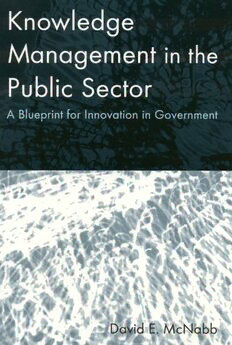
Knowledge Management in the Public Sector: A Blueprint for Innovation in Government PDF
Preview Knowledge Management in the Public Sector: A Blueprint for Innovation in Government
Knowledge Management in the Public Sector Knowledge Management in the Public Sector A Blueprint for Innovation in Government David E. McNabb M .E.Sharpe Armonk, New York London, England Copyright © 2007 by M.E. Sharpe, Inc. All rights reserved. No part of this book may be reproduced in any form without written permission from the publisher, M.E. Sharpe, Inc., 80 Business Park Drive, Armonk, New York 10504. Library of Congress Cataloging-in-Publication Data McNabb, David E. Knowledge management in the public sector : a blueprint for innovation in government / by David E. McNabb. p. cm. Includes bibliographical references and index. ISBN-13: 978-0-7656-1727-9 (cloth : alk. paper) ISBN-10: 0-7656-1727-7 1. Knowledge management. 2. Organizational learning. 3. Public administration— Information technology—Case studies. 4. Electronic government information—Case studies. I. Title. HD30.2.M398 2006 352.3'8—dc22 2006005776 Printed in the United States of America The paper used in this publication meets the minimum requirements of American National Standard for Information Sciences Permanence of Paper for Printed Library Materials, ANSI Z 39.48-1984. ~ BM (c) 10 9 8 7 6 5 4 3 2 1 For Meghan, Michael, and Sara. Contents List of Tables, Figures, and Boxes ix Introduction xi Part 1. Foundations of Knowledge Management 1 1. Historical Foundations of KM 3 2. KM: A Self-Regulating Social System 23 Part 2. Transforming Government with KM 43 3. The Technology and Processes Subsystem 45 4. Knowledge Processes and Policy Directives 64 5. Principles and Processes in Implementing KM 83 6. Building a Collaborative Learning Culture 106 7. KM and Organizational Learning 125 Part 3. KM Systems in the Public Sector 147 8. KM and Innovation in Government 149 9. Knowledge Management in the Public Sector 168 10. The Public-Sector Chief Knowledge Officer 188 Part 4. Stories of Public-Sector KM in Action 207 11. Knowledge Management at NASA Edward Hoffman, Jon Boyle, and Anthony J. Maturo 209 12. KM at the Army’s Communications-Electronics Command Susan L. Nappi 227 13. KM at the Virginia Department of Transportation Maureen L. Hammer 240 vii viii CONTENTS 14. Conclusion: Knowledge Management’s Role in the Drive to Transform Government 257 Glossary 275 Bibliography 291 About the Author 303 About the Invited Contributors 305 Index 307 List of Tables, Figures, and Boxes Tables 1.1 Twentieth-Century Efforts to Reform Government 11 2.1 A Comparison of Tacit and Explicit Knowledge 32 3.1 Five-Model Comparison of Perceived Critical KM Components 47 3.2 Knowledge Management Process and Supporting ICT Tools 51 3.3 Benefit Factors and Their Constituent Components 61 4.1 Four E-Government Collaboration Efforts Reviewed 70 4.2 KM Capabilities to Transform Information into Meaningful Knowledge 75 4.3 Additional Services Model (SRM) Domains and Capabilities with KM 77 5.1 Successful KM Implementation Principles and Practices 90 5.2 Partial Results of 2005 Performance Review on KM and Leadership 92 7.1 Alberta, Canada, Knowledge Management and Learning Organization Framework 133 Figures 1.1 From Data Processing to Full Knowledge Management Systems 9 1.2 Key Components of Early E-Government Systems 13 2.1 Fundamental Mechanisms, Processes, and Payoffs in a Public-Sector Knowledge Management System 26 2.2 How KM Subsystems Interact to Produce Learning and Generative Change 27 4.1 Mechanisms Facilitating Knowledge Management and Agency Collaboration 67 4.2 KM in the Federal Enterprise Architecture Reference Model (FY07) 74 4.3 Service Interface and Integration Service Areas 79 ix x LIST OF TABLES, FIGURES, AND BOXES 4.4 Evolution of Business Models into the President’s Management Agenda (PMA) of 2002 81 6.1 Organizational Factors Affecting the Culture of an Organization 112 7.1 A Model of the Knowledge Management and Organization Learning System 127 7.2 A Model of Single-Loop Learning 131 7.3 The APHIS Organizational Learning Cycle 135 8.1 How Learning and Knowledge Shape an Organizational Learning System 153 14.1 A Model of the Forces Shaping Transformation in Government 258 14.2 KM in the Federal Enterprise Architecture Reference Model (FY07) 262 14.3 A Continuum of Content Delivery Models with Illustrative Pedagogies 272 Boxes 1.1 The Federal Enterprise Architecture Program 12 4.1 Enterprise Architecture at the Department of Defense (DoD) 76 5.1 So What Is a Knowledge Audit? What Will It Investigate and Evaluate? 94 5.2 Mission Statement of the KM.gov Taxonomies and Semantics SIG 101 5.3 Some Technologies Used in Running Communities of Practice 102 6.1 Three Examples of a Culture of Collaboration in the Canadian Government 117 6.2 Great Lakes Interagency Task Force Collaborative Actions 120 6.3 Leadership Guidelines for Government CIOs and CKOs 123 7.1 Four Descriptions of Learning Organizations 129 7.2 A California City’s Transformation to a Learning Organization 130 7.3 From Khobar Towers to Pentagon Renovation 139 9.1 Building an Information-Sharing Culture in Europe 185 10.1 Excerpts from a Job Description for a Chief Knowledge Officer at GSA 192 10.2 Excerpts from a CKO Job Description for the FERC 193 10.3 Required Qualifications for a DoD KM Specialist 204
